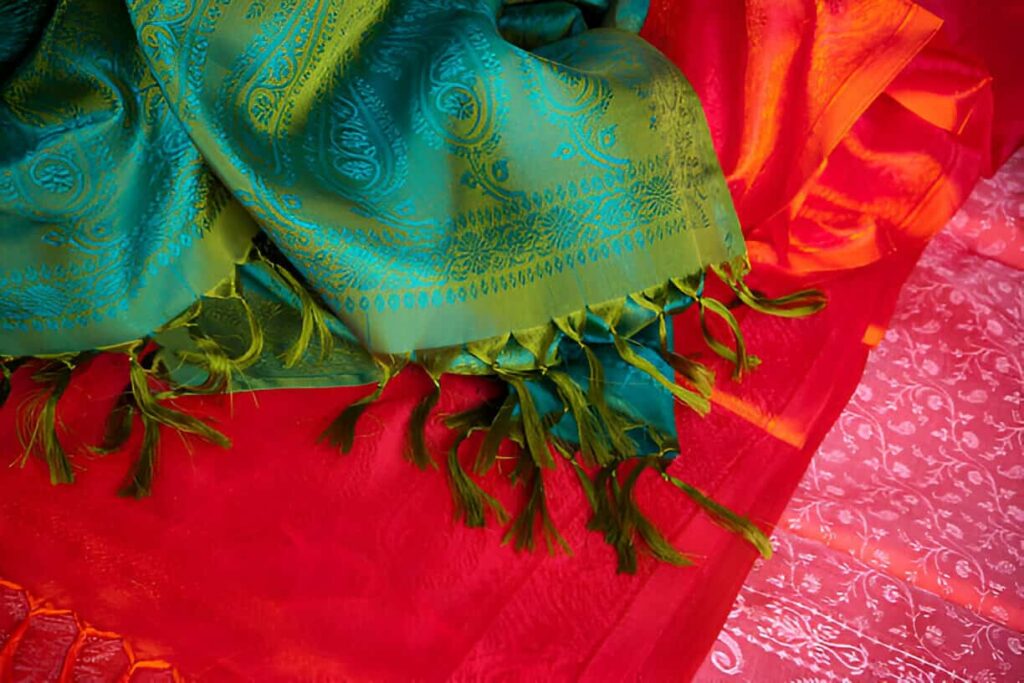India is known for its rich and diverse textile heritage, with each region offering its unique weaving techniques and styles. Sarees are among the most exquisite and luxurious. Sarees symbolise elegance and sophistication, often associated with royalty and nobility. Their intricate designs and vibrant colours make them a treasured possession for any saree enthusiast.
Paithani saree is renowned for its exquisite beauty, rich history, and intricate craftsmanship. Originating from Maharashtra, these sarees have been cherished by royalty and connoisseurs alike for centuries. So, to assist you in identifying authentic sarees from the many imitations on the market, this article offers five key features. By understanding these key characteristics, you can ensure that you are investing in a true masterpiece.
The Rich History
These sarees have a rich historical background, with origins tracing back to the Satavahana dynasty. Historically, they were woven with pure silk threads and real gold and silver zari. They were highly prized possessions, often exchanged as gifts among royalty. The traditional motifs, such as peacocks, lotuses, and vines, are inspired by the Ajanta Caves, which imbue the material with cultural and historical value.
1. Examine the Weave and Texture
The first step in identifying an original Paithani is to examine the weave and texture of the fabric. Genuine pieces are handwoven using high-quality silk and real gold or silver zari. The weaving technique involves interlocking wefts, resulting in a smooth, rich texture on both sides of the saree. When you run your fingers over the fabric, it should feel soft and luxurious, without roughness or unevenness. Authentic pieces often feature traditional motifs such as peacocks, lotuses, and vines, reflecting Maharashtra’s cultural heritage.
2. Check for Symmetrical Designs
An authentic piece will have symmetrical designs on both sides of the fabric. This is because the traditional weaving technique ensures the patterns are mirrored perfectly on the reverse side. Fold them in half and compare the designs on both sides to check for this. They should be identical, without any discrepancies or misalignment.
3. Inspect the Borders and Pallu
The borders and pallu (the decorative end of the saree) are often the most intricate and eye-catching parts of this saree. Authentic pieces will have elaborate and detailed work in these areas, created with real gold or silver zari threads. The borders are typically broad and adorned with different motifs, while the pallu showcases complex designs and vibrant colours. The designs should be consistent and meticulously crafted, reflecting the artisan’s expertise.
4. Verify the Weight and Feel
Authentic are relatively heavy due to the quality of the silk and the use of real gold or silver zari. When you hold them, it should have a substantial weight and a dense, luxurious feel. They should drape beautifully, with a natural flow and elegance. If they feel light or flimsy, it may signify inferior materials or poor craftsmanship. Genuine are durable and designed to last for generations, so the weight and feel of the fabric are essential indicators of authenticity.
5. Research and Buy from Reputable Sources
One of the best ways to ensure you are purchasing an authentic Paithani is to buy from reputable sources. This is especially important if you are looking to buy Paithani silk sarees online. Reputable sellers will provide detailed product descriptions, high-quality images, and certificates of authenticity. In addition to selling authentic products, they will have positive customer ratings.
Identifying an original Paithani saree is crucial for investing in this exquisite art form. Authentic sarees are beautiful garments and a testament to Maharashtra’s rich cultural heritage and skilled craftsmanship. Purchasing an authentic one ensures that you will have a treasured possession that will endure for years.



